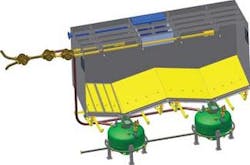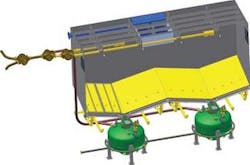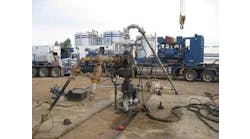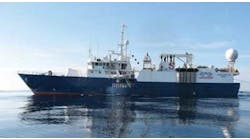Higher capacity, smoother discharge improve supply vessel cargo handling
Hopper and blow-pump bulk handling systems from MacGregor Selfunloaders increase storage capacity for offshore supply vessels (OSVs). Currently, systems are being installed on 10 newbuild vessels.
The company part of Cargotec Corp.’s MacGregor Group has derived the design for this equipment from its pneumatic conveying system to load and unload cement carriers, first introduced in 1947 and further refined over the years. In 2004, with the sudden boom in offshore vessel construction, the company decided to transfer its bulk handling expertise into this market.
MacGregor’s hopper and blow-pump bulk handling system offers gains in storage capacity compared with pressurized tanks.
Bulk cargoes carried by OSVs typically include barite and bentonite, as well as cement. “The major disadvantage with conventional bulk handling systems in OSVs is that they rely on pressurized storage tanks,” says Pankaj Thakker, senior sales manager for MacGregor Selfunloaders in Sweden.
During discharge, it is the pressure differential between the tank and the discharge line which, with the aid of compressed air, conveys the bulk material out of the tank. “Because the tanks are pressurized,” he adds, “they have to be circular, which is not an optimal shape when it comes to using the storage space in a vessel’s hull.”
The MacGregor solution instead stores cargo in hoppers, which have floors covered with aeration panels. The floors are tilted at an angle of 12º in the direction of the outlet, below which is situated a blow-pump. Discharge is achieved by passing air through the aeration panels. This fluidizes the cargo which, under the influence of gravity, flows to the outlet and drops into the blow-pump. When the chamber of the blow-pump is full, aeration stops, the outlet valve is closed, and compressed air conveys the bulk material from the pump through the discharge line.
Only the blow-pumps are pressurized. Since the hoppers are not pressurized, they are designed for optimal use of available space in the ship’s hull, meaning a rectangular shape. Moreover, they normally can be formed using the existing structure of the ship the longitudinal and transverse bulkheads for the walls and the underside of the main deck for the roof. Only the floor needs to be added. Thus, the hopper’s capacity is significantly greater than that of pressurized circular tanks fitted into the same space 50-75% greater, according to Thakker.
He cites one current delivery to a VS491 CD anchor-handler under construction at the Batamec Shipyard in Indonesia, in which bulk capacity will be about 500 cu m (654 cu yd). “This is almost 67% higher than the originally planned conventional bulk tank type system comprising four 75-cu m (98-cu yd) tanks with a total capacity of 300 cu m (392 cu yd).”
To speed discharge, each hopper has two outlets, one in each half. While one pump is filling with cargo, the other is discharging its load. The capacity of the blow-pump is 4 cu m (5.2 cu yd).
Less steel
There are other advantages. Less steel is needed to form the hopper, as it makes use of existing bulkheads and deck. In contrast, the pressurized tank has to be built. Moreover, because it is pressurized, it needs thicker walls, sometimes up to 20 mm (0.8 in.), which further adds to the required volume of steel.
In addition, the internal wall of the pressurized tank has to have a special coating of epoxy primer to ensure none of the cargo sticks to it. No special treatment of the internal wall is required for the hopper.
MacGregor also has developed a two-way valve to replace the butterfly valve at the junction where the cargo transfer line splits into the loading line which enters the top of the hopper and the discharge line running from the blow-pumps. When opened, the butterfly valve has a blade in the cargo stream, and so tends to wear out.
The two-way valve overcomes any clogging in the line it has a disc which fits on the line that needs to be blocked. Since it does not intrude into the cargo stream, it suffers almost no wear and tear, Thakker says. It is fitted with an inspection cover for easy maintenance.
The MacGregor system avoids clogging the discharge line due to high humidity in the air used for conveying the cargo (which often leads to the air being passed through refrigerant dryers). In the case of the hopper and blow-pump system, between each fill and discharge cycle of the blow-pump, the whole discharge line is blown clean.
“To fully realize the benefits of the self-unloading system, it should be taken on board at the project’s design stage,” Thakker says. “It should be emphasized that the hopper and blow-pump system is integrated within the structural design of the vessel, and early discussions between ship designer and system designer are crucial for successful implementation.”
The first hopper and blow-pump systems for offshore application are now being fitted in four offshore vessels under construction at Batamec for Mosvold Supply. Last year the company also received orders for six newbuild vessels from Arabian Gulf’s Whitesea Shipping & Supply.
For more information contact Pankaj Thakker, Cargotec Sweden, MacGregor Selfunloaders. Tel +46 171 232 56, fax +46 171 232 99,[email protected], www.macgregor-group.com




